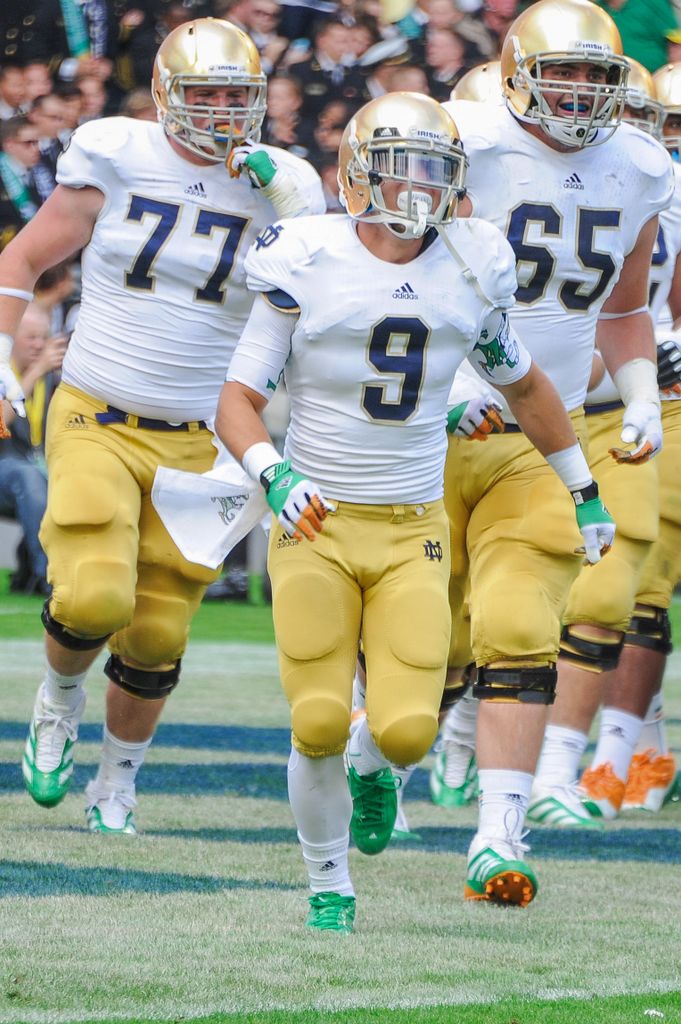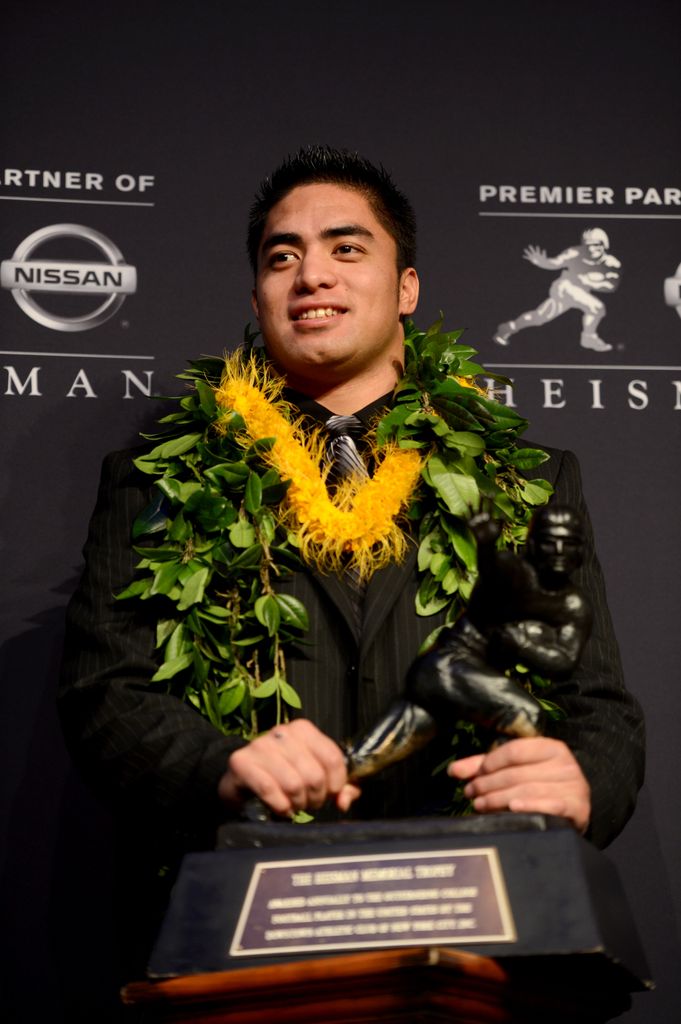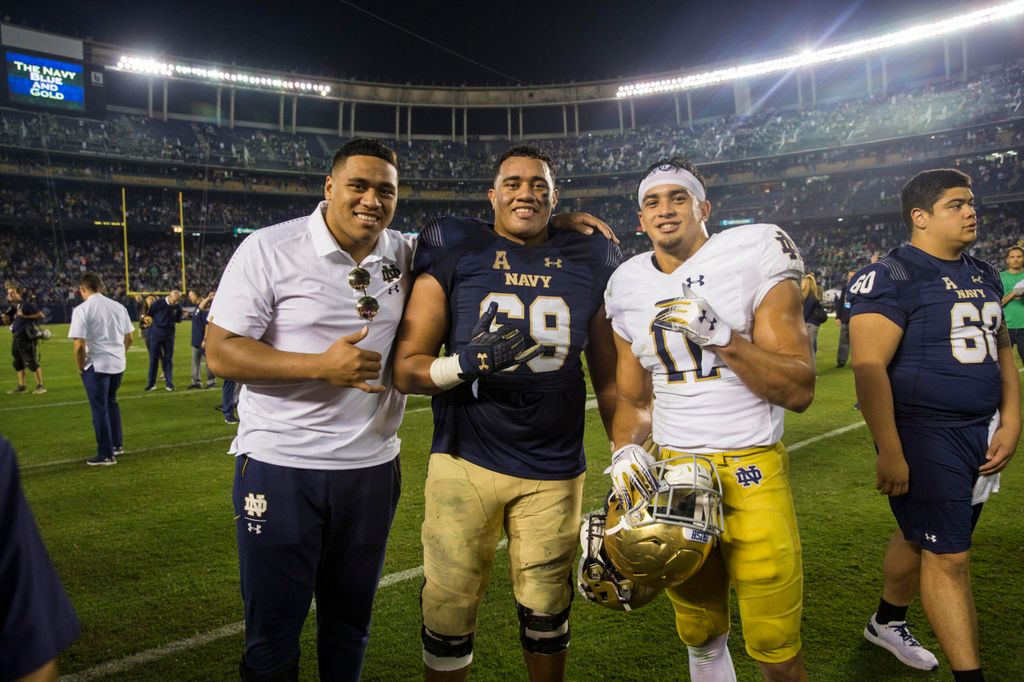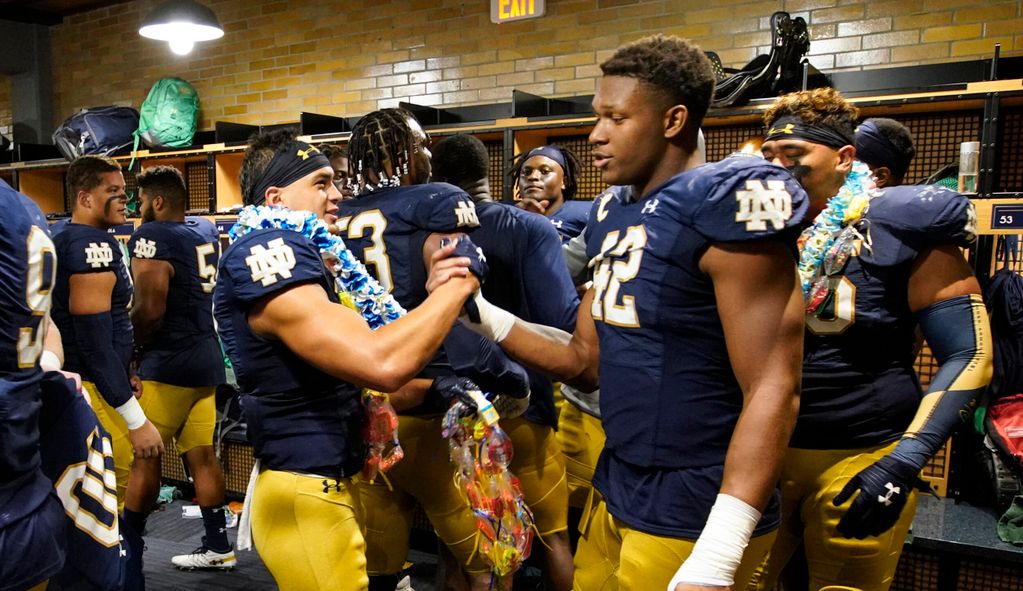Aloha, Irish: Notre Dame-Hawaii Pipeline Continues to Grow
By Denise SkwarcanEditor’s Note: This story will appear in Saturday’s edition of Gameday Magazine, the official game program of Notre Dame football. Programs are available for purchase throughout campus and feature all you need to know about Notre Dame student-athletes, coaches, history and opponents.
Hawaii.
It is a word that conjures up a multitude of images that are reflective of a beautiful, tropical group of islands located in the Pacific Ocean. Palm trees, coconuts, pineapples, surfers riding big waves, romantic getaways, Hula girls, leis, volcanoes and football.
Wait, football?
OK, maybe that term doesn’t exactly fit with the others just yet. At least not in the way that people associate football with Texas and Florida and California. But there’s been palpable progress, in large part, thanks to Notre Dame special teams and recruiting coordinator Brian Polian.
“It was mostly linemen that got recruited (before me),” recalled Robby Toma, a wide receiver from Laie, Hawaii, who played for the Irish from 2009-12. “I think (linebacker) Manti (Te’o), at that time, was probably the highest-rated player in Hawaii history, but prior to that skill players really didn’t get a lot of love from colleges. It wasn’t until we played in a Hawaii vs. Mainland All-Star game that I started getting looks. I even got an invitation to the Under Armour All-American game. Obviously, there have been other players from Hawaii skillwise that have been recruited but I think around that time was when they started realizing that skill players out here could play as well. Now you’re seeing a wide range of skill players (from Hawaii) getting recruited.”
In The Beginning
Over the years, dozens of high schools scattered throughout the United States have churned out many top-tier football players that have signed with the Irish. There’s Mater Dei and De La Salle in California, IMG Academy and St. Thomas Aquinas in Florida, and Katy High School in Texas. There’s east coast school DeMatha in Maryland and a handful of Indiana schools located in and around Indianapolis. Obviously, Notre Dame’s history with these and other schools didn’t just result in full-blown relationships overnight.
But they are ones that have been nurtured and maintained for years, ones that are somewhat easy with which to connect. When Notre Dame has a road game in California or Florida, one or two coaches can take a quick recruiting trip nearby before heading home. Several high schools or in-home visits can be checked off during a day or two spent in Texas. Chicago, parts of Michigan, Ohio and Kentucky – not to mention Indiana – can all be reached by car in a matter of hours.

Hawaii is a whole other ball game, so to speak. It can be costly and time-consuming to recruit there. A non-stop flight out of Chicago is approximately nine hours to cover the 4,000-plus miles and three time zones, which can mess with anyone’s internal clock. Polian had the desire to cultivate a Hawaiian connection … he just needed the patience for it to evolve.
“Recruiting anywhere is relationship-driven, but it is very relationship-driven here in Hawaii,” Polian told The Athletic. “When I came here to Hawaii the first time I didn’t know anybody, literally hanging around door to door at the schools. Would get teased by the local coaches being as pasty as I am, not having any clue what I was doing.”
Hawaii most likely will never be a Texas or Florida when it comes to producing prep football talent, but the investments Notre Dame is making in the Aloha State are paying off.
“I guess maybe because we’re detached from the mainland people think we can’t compete with mainland schools,” noted Myron Tagovailoa-Amosa, a senior defensive lineman from Kapole High School in Ewa Beach, Hawaii. “So you always see a different pride when it comes to Hawaii players trying to help other boys back home get noticed. Colleges should definitely take a trip to check out the physicality and the uniqueness we have. The Hawaii boys can put on a show and we take pride in where we come from just like any other person would. But I feel like being from Hawaii and being separated from the mainland that we give off a different kind of vibe.”
"The Hawaii boys can put on a show and we take pride in where we come from just like any other person would. But I feel like being from Hawaii and being separated from the mainland that we give off a different kind of vibe." - Myron Tagovailoa-Amosa
The Big Catch
Hawaii also is known for its deep-sea fishing excursions. But it wasn’t any kind of fish Polian and the Irish reeled in little more than a decade ago. It was a linebacker from Punahou School in Honolulu, the first five-star player from the state since 2002’s Jonathan Mapu, a defensive tackle from Kahuku, Hawaii, who played at Tennessee. Manti Te’o was arguably one of the most heralded recruits in the history of of the state.
Te’o inked with the Irish in February 2009 after turning down offers from USC and BYU. It was one of the biggest upsets of that recruiting cycle that eventually helped propel Notre Dame back into the national spotlight. By the time his four-year career had ended, the Irish had played for a national championship and Te’o had finished as the Heisman Trophy runner-up in 2012.
“I look back at it, boy, was I young and stupid, just killing myself,” Polian told The Athletic. “But his recruitment changed my career. There is no doubt in my mind. I went from Bill Polian’s son who was working at Notre Dame to Brian Polian, at the age of 32 or 33, who pulled off one of the biggest upsets in recruiting that year. It kind of gave me my own identity in college football. I’ve told Manti that, too.”

In addition to Te’o, the Irish also signed wide receiver Robby Toma, a teammate of Te’o’s at Punahou who outperformed his two-star recruiting ranking during his time in South Bend. The following year, the late Kona Schwenke, a defensive lineman from Kahuku High School, chose Notre Dame. He played in 31 games for the Irish, starting nine, and won Notre Dame’s Next Man In Award as a senior in 2013.
Clearly, this trio helped open the door for other Hawaiian kids down the road.
“I remember when Manti and Robby and that whole crew came out here … there were so many people that didn’t even know where (Notre Dame) was located,” stated Alohi Gilman, the current Irish safety who hails from the same high school as Schwenke. “But now you have a whole community across the state who keeps an eye on us and is aware of what we’re doing here, and now we’re an example of what we have here (at Notre Dame).”
Beyond 2012
In the years since Te’o and company committed to the Irish, Tagovailoa-Amosa and freshman Marist Liufau, a freshman linebacker from Punahou, also have joined the list of Polynesian recruits who have been or are currently on the Notre Dame roster. That’s five players, and it doesn’t even include Gilman, who transferred to Notre Dame in 2017 after spending his freshman campaign at Navy the year before. While that may not seem like a lot, consider that during that same period the Irish signed just seven players from Michigan.

And like the players before them, the current trio is making its mark. Tagovailoa-Amosa will likely be a three-year starter for the Irish, and has accounted for 12 tackles and a recovered fumble through five games. During that same period Gilman was responsible for 29 tackles, good for second on the team, and stands to become a two-time captain should he return for a fifth year of eligibility next season. And, although his playing time as been limited this season so far, Liufau has gotten onto the field.
“I think we carry a little bit different of an attitude because we feel like we can compete with anyone in the country,” Gilman said.
Hawaii may never be known as a hotbed for recruiting, but clearly Polian’s hard work, along with the advancement of social media, has given players from Hawaii more attainable choices.
“I kind of think the norm for student-athletes coming out of Hawaii (in the past) was that nobody went east of the Mississippi,” said Toma, who spent two years at Punahou School as receivers coach in 2017 and co-offensive coordinator in 2018. “Now I think access is the biggest thing. I remember Manti and I and his father and my parents as well … we used to have to burn CDs and DVDs and we sent them to every college in America. Now you have things like Hudl and Twitter and Instagram.”
Leaning on Ohana
Hawaiian players might not be so cut off from the rest of the United States anymore when it comes to visits from and communication with college coaches. But the distance between home and where they’ll spend at least the next four years of their lives is part of the decision-making process. That’s where Ohana, the Hawaiian word for “family,” comes in.
“The biggest adjustment was learning how to become independent without your family being so close,” Tagovailoa-Amosa commented. “Literally everyone that you grew up with is on that small island so you have to make new friends and family out here. That’s how we try to strengthen the Hawaii pipeline because the more Hawaii guys that come out … we have the big struggle of being so far away from home but because we all represent the same culture we all kind of bond over that.”

“(The distance mattered to me) because family means a lot and it’s hard traveling from Hawaii to here. It’s really expensive and it’s far,” Liufau added. “It’s hard to get a lot of family members here. So it was definitely difficult to choose between a West Coast school and here but at the end of the day this was the best place for me and I stuck with it.”
That familial connection also is helpful for players who are curious about Notre Dame and, like big brothers, Toma and Te’o are willing to answer questions and offer advice about their experiences.
“It’s funny because the kids are always intrigued about playing on a big stage,” Toma said. “When you have an opportunity to play in games from when you’re 18 to 22 in that moment you kind of forget how cool it is. But now that I’m a little bit older and I can share my experiences with the high school kids I get a chance to look at it and say, ‘Damn, that was pretty cool.’”
Still, at the end of the day, while the number of miles is a consideration, Notre Dame has so many things so offer regardless of where the player calls home.
“Notre Dame sells itself,” Toma noted. “It’s true when they say it’s not a four-year deal but a 40-year deal. That holds true and then the campus and the tradition is something that all student-athletes at Notre Dame are so proud of and that tradition just can’t be duplicated.”
Down The Road
In due time, Gilman and Tagovailoa-Amosa and Liufau will move on like Te’o and Toma and Schwenke did before them, making room for up and coming players. Gilman’s younger brother, Alaka’i, is a standout out Punahou. Honolulu linebacker Jordan Botelho received an offer from Notre Dame earlier this year. And it’s probable, even likely, that without Te’o there is no trickle-down effect.
“Manti had a helluva a career and guys like myself and Kona Schwenke, who were lucky enough to go to Notre Dame, kind of showed that we can make an impact at that level,” Toma noted. “Even though we’re far away from home, home will always be the same and we’ll carry that Aloha spirit no matter where we go.”






